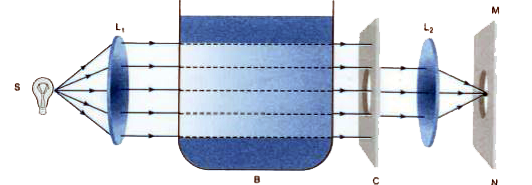With the help of an activity show the blue colour of the sky and the reddish appearance of the sun at the sunrise or sunset.
Text Solution
Activity:
(i) Place a source of light such as an electric bulb at the focus of a converging lens L. This lens provides a parallel beam of light.
(ii) Allow the light beam to pass through a transparent glass beaker B of capacity 500 mL.
(iii) After passing through the beaker containing about 400 mL of water allow the light beam to pass through a circular hole made in cardboard C. Obtain a sharp image of the hole on a screen MN using another convex lens L2.
(iv) Dissolve about 200 g of sodium thiosulphate (hypo) in water taken in the beaker B. Add about 1 to 2 mL of concentrated sulphuric acid with the help of an injection syringe dropwise in the beaker containing hypo solution.
(v) What do you observe?
You will notice fine microscopic sulphur particles precipitating in about 2 to 3 seconds. As the sulphur particles begin to form, you can observe the blue light from the sides of the beaker This is due to scattering of short wavelengths by minute colloidal sulphur particles. Observe the colour of the light patch on the screen. It is interesting to observe the change in colour of the patch-from orange red colour in the beginning to bright crimson red colour later on the screen.

This activity demonstrates the scattering phenomena of light that helps us to understand the bluish colour of the sky in general and the reddish appearance of the sun at the sunrise or the sunset.
|
Topper's Solved these Questions
- THE HUMAN EYE AND THE COLOURFUL WORLDBOOK - VK GLOBAL PUBLICATIONCHAPTER - THE HUMAN EYE AND THE COLOURFUL WORLDEXERCISE - SOME IMPORTANT QUESTIONS
3 Videos
- THE HUMAN EYE AND THE COLOURFUL WORLDBOOK - VK GLOBAL PUBLICATIONCHAPTER - THE HUMAN EYE AND THE COLOURFUL WORLDEXERCISE - HOTS (Higher Order Thinking Skills)
6 Videos
- THE HUMAN EYE AND THE COLOURFUL WORLDBOOK - VK GLOBAL PUBLICATIONCHAPTER - THE HUMAN EYE AND THE COLOURFUL WORLDEXERCISE - SHORT ANSWER QUESTIONS-II
15 Videos
- SOURCES OF ENERGY BOOK - VK GLOBAL PUBLICATIONCHAPTER - SOURCES OF ENERGY EXERCISE - SHORT ANSWER QUESTIONS - II
16 Videos
- VALUE-BASED QUESTIONSBOOK - VK GLOBAL PUBLICATIONCHAPTER - VALUE-BASED QUESTIONSEXERCISE - EXERCISE (CHAPTER-16) MANAGEMENT OF NATURAL RESOURCES
9 Videos
Similar Questions
Knowledge Check
The blue colour of the sky and the redding of sun at sunrise and sunset is caused due to
Ascattering of lightBreflectionCthermal effectDatmospheric diffractionWhich of the following phenomena contributes significantly to the reddish appearance of the sun at sunrise or sunset?
ADispersion of lightBScattering of lightCTotal internal reflection of lightDReflection of light from the earthWhich of the following phenomena contributes significantly to the reddish appearance of the Sun at sunrise or sunset ?
ADispersion of light.BScattering of light.CReflection of light.DRefraction of light.
The sun looks reddish at the time of sunrise and sunset.
View SolutionThe sun looks reddish at the time of sunrise and sunset.
View SolutionThe colour of the sky appears blue due to
View SolutionBlue colour of sky and red colour of sunsets are due to
View SolutionThe red colour of the sun at the time of sunrise and sunset is because :
View Solution
